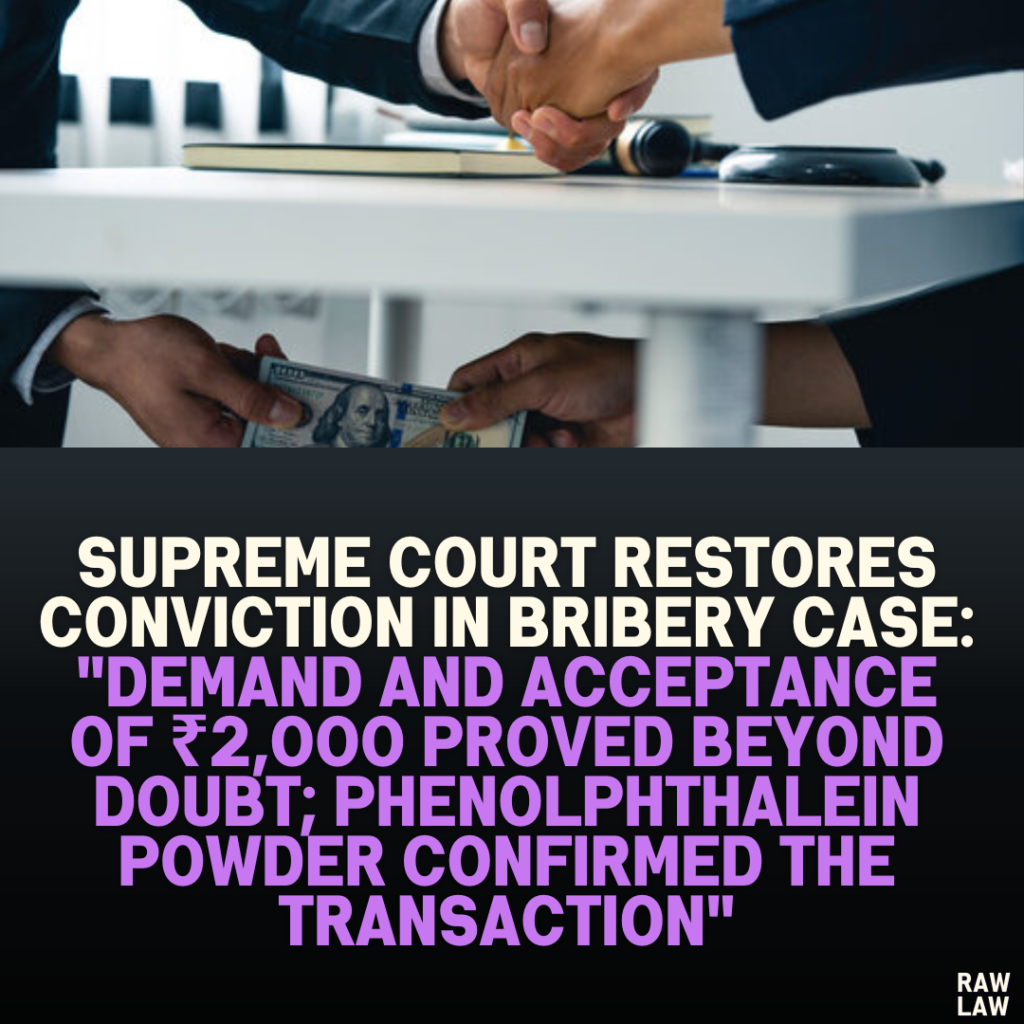Court’s Decision
The Supreme Court overturned the High Court’s acquittal of the respondent, restoring the trial court’s conviction under Sections 7 and 13(1)(d) read with Section 13(2) of the Prevention of Corruption Act, 1988. The respondent was sentenced to imprisonment and fined as per the trial court’s order. The Court emphasized the importance of combating corruption, stating:
“The prosecution proved its case beyond any reasonable doubt.”
Facts
- Context: The complainant, a school employee, submitted a bill for encashment of leave salary to the Sub-Treasury Office, where the respondent was employed as a First Division Assistant.
- Allegation: The respondent allegedly demanded a bribe of ₹2,000 to process the bill and issue the corresponding cheque.
- Complaint and Trap:
- The complainant recorded the respondent’s demand using a tape recorder.
- He lodged a complaint with the Lokayukta Police, which arranged a trap to catch the respondent in the act of accepting the bribe.
- Evidence:
- During the trap, the respondent accepted the bribe and was caught red-handed.
- Phenolphthalein powder applied to the currency notes confirmed the transaction.
- Legal Proceedings:
- The trial court convicted the respondent based on evidence, sentencing him to imprisonment and fines.
- The High Court acquitted the respondent, citing the absence of pending work as evidence that the bribe was not demanded for an official act.
Issues
- Whether the prosecution proved the demand and acceptance of a bribe.
- Whether the High Court erred in acquitting the respondent despite evidence of demand and recovery.
- Whether procedural compliance, including obtaining proper sanction for prosecution, was met.
Petitioner’s Arguments
- Proof of Demand and Acceptance:
- The complainant’s testimony, tape-recorded conversation, and corroborative evidence established the demand and acceptance of a bribe.
- The recovery of tainted money corroborated the prosecution’s case.
- Presumption of Guilt:
- Section 20 of the Prevention of Corruption Act creates a presumption of guilt upon proof of acceptance of gratification, and the respondent failed to rebut it.
- High Court’s Misinterpretation:
- The High Court wrongly concluded that the absence of pending work negated the demand for a bribe, ignoring that the cheque was withheld without justification.
Respondent’s Arguments
- Defense of Loan Transaction:
- The money recovered was a repayment of a loan, not a bribe.
- The respondent had no official reason to demand a bribe, as the cheque was already prepared before the trap.
- High Court’s Acquittal Justified:
- The High Court rightly noted that no pending official work required the respondent to process the bill.
Analysis of the Law
- Demand and Acceptance:
- Under Sections 7 and 13(1)(d) of the Prevention of Corruption Act, demand and acceptance of illegal gratification must be proven beyond a reasonable doubt.
- Mere recovery of money does not suffice unless the prosecution establishes the foundational facts of demand and acceptance.
- Presumption under Section 20:
- Section 20 presumes that gratification is received for an illegal purpose once acceptance is proven.
- This presumption is rebuttable, but the respondent failed to provide evidence supporting his claim of a loan transaction.
- Procedural Compliance:
- The prosecution obtained the necessary sanction from the competent authority before initiating proceedings, ensuring compliance with statutory requirements.
Precedent Analysis
- C.M. Girish Babu v. CBI: Proof of demand and acceptance is critical for conviction under the Prevention of Corruption Act.
- B. Jayaraj v. State of A.P.: Mere possession of tainted money is insufficient; demand must be proven.
- Neeraj Dutta v. State: Circumstantial evidence can establish demand and acceptance if direct evidence is unavailable.
Court’s Reasoning
- Demand and Acceptance Proven:
- The complainant’s testimony, corroborated by audio recordings and the recovery of tainted money, clearly demonstrated the respondent’s demand and acceptance of a bribe.
- Witnesses, including panchas and investigating officers, provided consistent evidence supporting the prosecution’s case.
- Flawed High Court Reasoning:
- The High Court erred by focusing on the absence of pending work. The Supreme Court clarified that withholding the cheque constituted misuse of office, fulfilling the requirement of an official act.
- Respondent’s Defense Rejected:
- The claim of a loan transaction was unsupported by evidence. There was no close relationship between the respondent and the complainant to justify a loan.
- Presumption under Section 20:
- The Court upheld the presumption under Section 20, noting that the respondent failed to rebut it with credible evidence.
Conclusion
The Supreme Court restored the trial court’s conviction, directing the respondent to serve the remaining sentence and pay the imposed fines. The Court emphasized the need to uphold public confidence in the fight against corruption.
Implications
- Reinforcement of Anti-Corruption Laws:
- The judgment underscores the importance of proving demand and acceptance in corruption cases.
- It highlights the utility of presumptions under Section 20 of the Prevention of Corruption Act, strengthening the prosecution’s case when foundational facts are proven.
- Accountability for Public Servants:
- The decision sends a clear message that public servants cannot misuse their office for personal gain, even in cases involving small sums.
- Role of High Courts:
- The judgment cautions High Courts against relying on technicalities to acquit accused persons, emphasizing the need to consider the entirety of evidence.




Pingback: High Court of Jammu & Kashmir and Ladakh Rules on Seniority Dispute: "Court Cannot Travel Beyond Original Judgment" - Raw Law